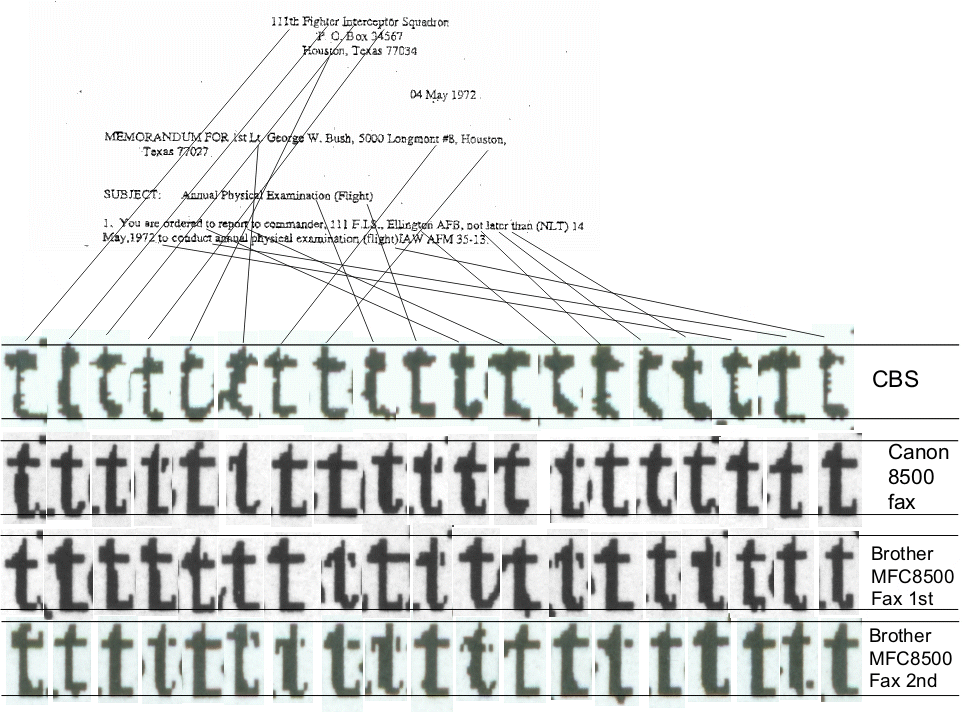
The Bush "Guard memos" are forgeries!
Type Wear Is Meaningless
|
|
Home |
 |
Resume |
 |
The Bush "Guard memos" are forgeries!Type Wear Is Meaningless |
|
Back to my response to Hailey's diatribe.
In his analysis of the Bush Guard memos, David Hailey Jr. makes some nonsensical assertions about how he can prove the memos are authentic because they exhibit artifacts of "type wear" that could only occur if the documents had been typed on an actual typewriter.
To make these assertions, he has to assume that it is possible to violate several fundamental principles of information theory, including pixelization and the Nyquist Sampling Limit.
He has no idea how to commit science; a scientist attempts to validate experiments. In the case of the "type wear", the validation experiment is trivial.
What I did was type up a copy of one of the memos in Microsoft Word (thus duplicating the original memo). I then faxed three copies to myself. One from a Kinko's, one from another fax machine, and the third from the same fax machine as the second.
Then I scanned the printout of the CBS memo, printed at 600dpi on a Xerox N4025 printer, at 2400dpi and extracted the letter "t", which Hailey considers shows definitive damage on the top left. He furthermore claims, on page 18 of his report (the caption of Figure 13), "In all cases in these memos, the left half of the cross stroke and/or the ascender of the "t" is incomplete". This is important. He sees something that does not exist (or, to be precise, he sees the nonexistence of something that does demonstrably exist). I can't even find the damage he describes in a single memo, let alone in all memos! Thus, with only one memo as a counterexample, his assertion is solidly disproved.

What we see here is a comparison of the same letter "t" from the 04-May-1972 memo. You, too, can repeat this experiment yourself. Do you see consistent damage of the type Hailey claims exists? Note that he carefully ignores the incredible variations of the lower curve of the "t". He does not offer a theory for why this should be so. He uses his hypothesis to not just predict that he will see this damage in every instance of the letter "t" in all memos, but claims he actually sees this damage.
Remember, you, too, can reproduce this experiment! You can look at the letter "t" in every memo yourself. You can make a Word document and fax it to yourself! You can replicate this experiment.
Now, look at the other three lines. The first line was faxed from a Canon 8500 fax from a Kinko's in the Oakland location in Pittsburgh PA (I can produce the receipt that proves I did this). Study the letter "t". Note that my copy has not been rescanned, converted to PDF format, unconverted, printed, and rescanned, yet there are substantial differences in the letter "t". The vertical component is of varying widths; in some cases the crossbar is small, in some it is large, in one cass the right of the crossbar is missing entirely. The bottom of the "t" is sometimes curved, sometimes square. Even if there had been wear on the type, do you think it would have survived the faxing process? Particularly wear as minute as he claims.
So I located another fax machine, in fact, the identical brand to mine, a Brother mFC8500. I faxed a copy of the very same memo to myself, again, and scanned it at 2400dpi. Note that the letter "t" is almost entirely different in all instances. So the letters, according to Hailey's analysis, would be showing a different wear. So I decided to repeat the experiment. I had the document faxed again from the same fax machine as the second fax. Note the damage appears different yet again.
Given the massive differences we see here, how is it possible that Hailey can make a claim that he can see "type damage"? Yet he becomes offended that I call his conclusions complete nonsense.
It is the nature of scientific inquiry that if you make a hypothesis, you use it to attempt to predict behavior. Had he understood this, he would have taken those examples that he uses to illustrate "type wear", faxed them to himself, and analyzed the faxes. It would be important to validate the experiment by faxing a copy of undamaged type, and compare the damaged type faxed image to the undamaged type fax image, and demonstrate that after faxing, the damage artifacts are readily visible in comparison with the undamaged type. It is very clear from the image above that such an experiment would show that it is impossible to distinguish damaged type of the kind Hailey claims from a faxed image of undamaged type (such as the three faxed image lines above, which are all from undamaged type, specifically, Microsoft Word output).
Please feel free to quote this material, use any of my images, etc. if you are reposting. I do ask that you provide a link to this page.